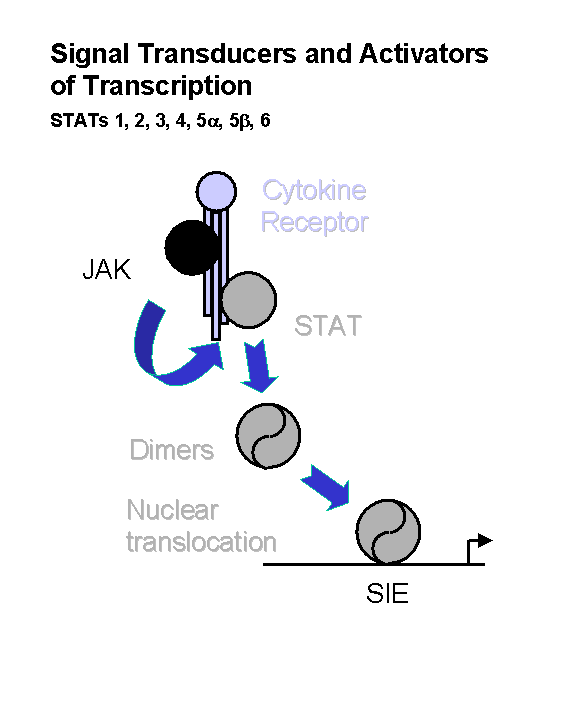 |

School of Biomedical Sciences, Faculty of Medicine and Health Sciences, Queens Medical Centre, Nottingham NG7 2UH, UK. |
 |
 |

School of Biomedical Sciences, Faculty of Medicine and Health Sciences, Queens Medical Centre, Nottingham NG7 2UH, UK. |
 |
STATS and Oncogenesis
|
Signal Transducer and Activator of Transcription (STAT) proteins were originally identified as downstream mediators of cytokine receptor signalling. They comprise a family of evolutionarily conserved transcription factors involved in immune function and to date seven mammalian STAT proteins have been identified. STATs are thought to be latent cytoplasmic proteins that are recruited to activated cytokine receptors where they are phosphorylated by Janus Kinases (JAKs). Phosphorylated STATs form dimers and translocate to the nucleus where they bind to the promoters of their target genes. (See Figure). Our interest in STATs stems from the finding that members of the family, especially STAT3, are involved in regulation of cell proliferation and determination of cell fate. Notably, STAT3 is constitutively active in cells transformed by a selection of oncogenes and in many human breast carcinoma (BC) lines. Current work is directed at understanding the signalling events that upregulate STAT3 in BC cells and identifying ways in which STAT3 activity, and consequently cell proliferation, can be downregulated. |
 |
|
|
References
Li, L. and Shaw, P.E. (2002). Autocrine-mediated Activation of STAT3 Correlates with Cell Proliferation in Breast Carcinoma Lines. J. Biol Chem. 277, 17397-17405.
Li, L., Hooi, D., Chhabra, S, R., Pritchard, D., Shaw, P.E. (2004). Bacterial N-acylhomoserine lactone-induced apoptosis in breast carcinoma cells correlated with down-modulation of STAT3. Oncogene. 23, 4894-4902.
Li, L. and Shaw, P.E. (2004). A STAT3 dimer formed by inter-chain disulphide bridging during oxidative stress. Biochem. Biophys. Res. Com. 322, 1005-1011.